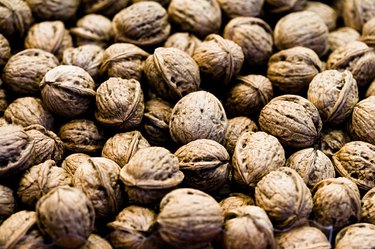
The black walnut (Juglans nigra) tree has been a source of food and lumber for thousands of years in Europe, Asia and Africa. In North America, the tree originated in the northeastern regions and slowly spread across the continent to California. The stately tree, grown most successfully in U.S. Department of Agriculture zones 4 to 9, makes its presence known with its massive height and width but does have a dark side: It is toxic to many companion plants. Maturing the tree for wood is a task that probably won't see results for a generation, while growing it for nuts may take from seven to 15 years.
Cold Hardy Nut Trees
Video of the Day
While black walnuts are considered cold hardy, they won't produce nuts when grown in a climate colder than hardiness zone 4. Other cold hardy nut trees include the Red Oak (Quercus Rubra) that thrives in extremely cold temperatures, the hazelnut (Corylus Americana) that grows in zone 3, the Manchurian apricot (Prunus mandshurica) that produces nuts when grown in zone 3, and the butternut (Juglans cinerea), also known as the white walnut and the most cold resistant of the different walnut types.
Video of the Day
Most commercial nurseries providing stock for nut trees grow their trees in zone 5 and designate cold hardy trees as those that thrive in temperatures down to -20 degrees Fahrenheit. When starting a black walnut tree from stock, choose a nursery or provider that is familiar with the geography of your location and the swing in temperatures.
Identifying Walnut Types
There are many different walnut types, including several black walnut varieties. The North American black walnut grows mainly in the Northeast, while the Northern California black walnut (Juglans hindsii) flourishes east of the San Francisco Bay area – the area that produces the walnut also known as the English walnut. The Eastern black walnut (Juglans Nigra) extends its growing area from the Northeast down through the Mississippi River to Louisiana, while the Texas black walnut (Juglans microcarpa) is scattered throughout Texas, Oklahoma and New Mexico. The tan, mild-tasting English black walnuts are the most familiar to consumers and those most often sold commercially.
Black walnuts have a distinct, earthy taste which doesn't appeal to everyone and are marketed to a specialized consumer. The shells are hard and difficult to open and give off a dark brown stain from the husk. Native Americans often used the husks to produce dye. It's best to wear gloves when shucking them. The wood from the black walnut is dense and resistant to decay, making it ideal for construction projects. However, it may take up to 25 years for a black walnut tree to mature for wood harvesting.
Growing Walnuts for Food and Wood
Black walnuts are self-fertilizing with the help of the wind, and they root very deeply so should be planted at a distance from the next tree. Tree plantations are cautious regarding placement of these trees because the roots produce a toxic herbicide known as juglone, which is also found in the tree's leaves and the husks of the nuts. This substance acts as a defense mechanism against invading plants and eliminates competition for soil nutrients and water.
The nuts drop from the tree from late summer through October and create quite a mess on the ground if not harvested by humans or squirrels. When planting black walnuts for food, expect the tree to produce in five to seven years after the seedling is planted. Planting a walnut tree plantation for wood should be cyclical, as the trees take years to mature to the point of cutting them down.
- Mansfield News Journal: In the Garden: Growing Black Walnut Trees is Easy But it Takes Time to Produce Nuts
- Arbor Day: Tree Guide: Black Walnut
- The Old Farmer’s Almanac: Black Walnut Trees
- Growing Wild: 33 Fruits and Nuts You Can Grow in an Extremely Cold Climate (Zones 1-4)
- University of California Davis: Walnut Origins, Breeding and Choosing Varieties